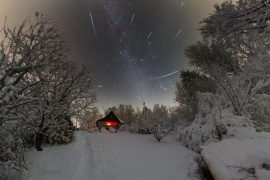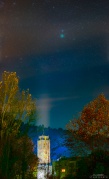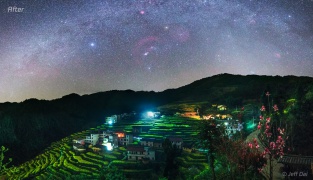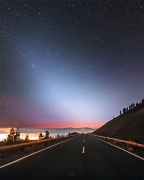Difference between revisions of "Getting Started in Astrophotography"
m (→Planetary Photography) |
m (→Nightscape Photography) |
||
| Line 24: | Line 24: | ||
File: Nightscape5.jpeg|07/24/2019|link=https://apod.nasa.gov/apod/ap190724.html | File: Nightscape5.jpeg|07/24/2019|link=https://apod.nasa.gov/apod/ap190724.html | ||
</gallery> | </gallery> | ||
| + | |||
| + | Nightscape photography is primarily done with DSLR cameras, non-tracking tripods, and standard lenses with short focal lengths. | ||
====Lunar Photography==== | ====Lunar Photography==== | ||
Revision as of 15:22, 28 August 2019
NOTE: this is a page in progress
A lot of people have at least a casual interest in Astrophotography (abbreviated AP). But most people know very little about how AP is done, or what it even is. Many seem to think it's as simple as just plugging a camera into the eyepiece receptacle of a telescope and snapping pictures. In reality, it's far more complex than that.
Contents
What is Astrophotography
At its heart, AP is about taking pictures of astronomical phenomena. This can be anything from images of the stars at night to images of galaxies and nebulae, and a whole bunch of stuff in-between.
Astrophotography is not a monolithic subject. There are a wide variety of sub-topics in AP, and each have different needs. There's no one-size-fits-all solution. But there is often a lot of overlap.
Let's break down the different kinds of AP:
Kinds of Astrophotography
Nightscape Photography
Nightscape photography is the type of astrophotography that combines scenery/landscape photography with the night sky overhead.
- Examples of Nightscape Photography From APOD
Nightscape photography is primarily done with DSLR cameras, non-tracking tripods, and standard lenses with short focal lengths.
Lunar Photography
As the name suggests, this would be pictures of the moon.
Planetary Photography
Again, as the name suggests, we're talking about pictures of planets here.
For the most part, however, there are only three planets that make good targets for photography: Mars, Jupiter, and Saturn.
•Mercury is too close to the sun, and too small. At its [maximum elongation], it only gets about 19° from the sun, which means that it's never visible far above the horizon. Because of this, any imaging will end up shooting through a thicker air mass, which typically degrades the image significantly. It's also so small that you're not going to see much anyway it its distance. Nevertheless, some people do attempt pictures. In them the most you are likely to see is the phases it displays, similar to those of the moon.
•Venus is not as close to the sun as is Mercury, but, being inside our orbit, it still doesn't rise all that high. At [maximum elongation], it only gets about 45° above the horizon. Venus is also fairly featureless, other than showing phases. The clouds block any surface features, and the patterns in the clouds themselves tend to be fairly subtle. Typically you would need a neutral density filter to reduce the glare, then another filter (I believe violet is the one of choice) to increase contrast enough to make out the features.
•Uranus is too distant and small to show much more than a blue-green disk to most amateur telescopes. Larger amateur scopes can occasionally get more out of it, but rarely.
•Neptune is about the same size as Uranus, but further out still, making any reasonable hope for capturing an image of Neptune somewhat hopeless.
•And if you count Pluto as a planet, just consider that the best image the HST could get is this:
As for extra solar planets: only the largest research telescopes have ever captured direct images of the most massive and nearby such stars. Your amateur scope has no real hope of imaging them, though detecting them is possible.
Comet Photography
Solar Photography
Deep Sky Photography
LEVEL 1
Level 1
LEVEL 2
Level 2
LEVEL 3
Level 3
LEVEL 4
Level 4
LEVEL 5
Level 5





